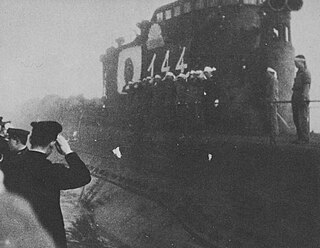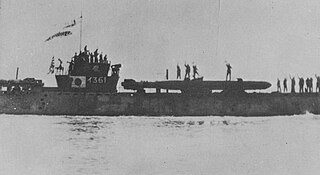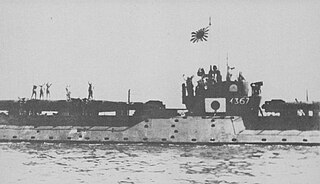Service history
Upon commissioning, I-363 was attached formally to the Yokosuka Naval District and was assigned to Submarine Squadron 11 for workups. [2] She departed Hikari on 8 August 1944. [2] With her workups complete, she was reassigned to Submarine Squadron 7 on 15 September 1944. [2]
Transport missions
On 9 October 1944, I-363 departed Yokosuka bound for Mereyon Island at Woleai in the Caroline Islands on her first transport mission, carrying 75 metric tons of food and supplies and 15 metric tons of other cargo. [2] En route, he stopped at Truk from 21 to 24 October 1944, where she picked up another 10 metric tons of cargo for Mereyon consisting of food and uniforms. [2] She arrived at Mereyon on 28 October 1944, unloaded five tons of fuel and supplies, embarked seven passengers, and got back underway the same day. [2] She returned to Truk on 31 October 1944, unloaded 33 metric tons of fuel oil, embarked 83 Imperial Japanese Navy Air Service personnel, and put back to sea on 2 November 1944 bound for Yokosuka, which she reached on 15 November 1944. [2] She got underway from Yokosuka on 30 November 1944 for a training exercise, but returned the same day after her commanding officer suffered an injury. [2]
I-363 departed Yokosuka on 10 November 1944 for her second transport voyage carrying a cargo of 88 metric tons of food, 10 metric tons of ammunition, and 10 metric tons of other supplies, this time setting course for Marcus Island, which she reached on 17 November 1944. [2] After unloading her cargo and embarking 60 passengers, she left the same day bound for Yokosuka, where she arrived on 26 December 1944. [2] She then began an overhaul. [2]
With the overhaul complete, I-363 put to sea from Yokosuka on 5 March 1945 for her third supply voyage, again bound for Marcus Island. [2] She arrived at Marcus on 13 March 1945, unloaded her cargo, and headed back to Yokosuka. During her voyage, Submarine Squadron 7 was deactivated on 20 March 1945 and she was reassigned to Submarine Division 15. [2] She reached Yokosuka on 30 March 1945. [2]
Kaiten carrier
While I-363 was on her return voyage from Marcus Island, U.S. forces captured advanced bases and anchorages in the Kerama Islands southwest of Okinawa between 26 and 29 March 1945, [2] and shortly after her arrival at Yokosuka, the Battle of Okinawa began when U.S. forces landed on Okinawa itself on 1 April 1945. [2] After reaching Yokosuka, I-363 was converted from a transport submarine into a kaiten suicide attack torpedo carrier, the conversion involving the removal of her 140-millimeter (5.5 in) deck gun and Daihatsu-class landing craft and their replacement with fittings allowing her to carry five kaitens on her deck, [2]
First kaiten mission
By 28 May 1945, I-363 was part of the Todoroki ("Thunderclap") Kaiten Group along with the submarines I-36, I-165, and I-361. [2] With five kaitens on board, she got underway from the kaiten base at Hikari that day bound for a patrol area between Okinawa and Ulithi Atoll. [2]
On 15 June 1945, I-363 sighted a convoy 500 nautical miles (930 km; 580 mi) southeast of Okinawa. With the seas too rough for her to launch her kaitens, she attacked with conventional torpedoes instead. [2] Her commanding officer believed she sank one merchant ship, although in fact she inflicted no damage. [2] On 18 June, she received orders to end her patrol and proceed to Hirao, Japan, which she reached on 28 June 1945. [2] She moved on to Kure on 29 June 1945. [2]
Second kaiten mission
Assigned to the TamonKaiten Group along with the submarines I-47, I-53, I-58, I-366, and I-367, I-363 departed Hikari on 8 August 1945, the last of the group's submarines to get underway. [2] She was assigned a patrol area 500 nautical miles (930 km; 580 mi) north of Palau, but on 12 August 1945 received orders to instead patrol in the Sea of Japan to defend the Japanese archipelago against a possible Soviet invasion. She was on the surface northwest of Kyushu on 14 August 1945 when aircraft of United States Navy Task Force 38 strafed her, killing two members of her crew but inflicting only minor damage on her.
Loss
On 27 October 1945, I-363 got underway from Kure bound for Sasebo. [2] She was off the coast of Miyazaki Prefecture on 29 October 1945 when she struck a mine that had been laid during World War II. [2] She sank with the loss of 36 lives. [2] There were 10 survivors. [2] She was stricken from the Navy list on 10 November 1945. [2]
I-8 was an Imperial Japanese Navy Junsen III -type submarine commissioned in 1938 that served during World War II. Designed as submarine aircraft carriers, I-8 and her sister ship I-7 were the largest Japanese submarines to be completed before the outbreak of the war in the Pacific in 1941. With embarked floatplanes, I-8 participated in operations related to the attack on Pearl Harbor, patrolled off the United States West Coast, and took part in the Guadalcanal campaign and the Okinawa campaign.

I-56, later I-156, was an Imperial Japanese Navy Kaidai-class cruiser submarine of the KD3B sub-class commissioned in 1929. During World War II, she supported Japanese forces during the invasion of Malaya in December 1941, the Dutch East Indies campaign in early 1942, and the Battle of Midway in June 1942. Except for brief service in the Aleutian Islands campaign in 1943, she subsequently served on training duties until selected for use as a kaiten manned suicide torpedo carrier in 1945. She surrendered to the Allies in 1945 after the end of the war and was scuttled in 1946.

I-57, later I-157, was an Imperial Japanese Navy Kaidai-class cruiser submarine commissioned in 1929. During World War II, she supported Japanese forces during the invasion of Malaya in December 1941, the Dutch East Indies campaign in early 1942, and the Battle of Midway in June 1942. She then served on training duties — except for a brief period of participation in the Aleutian Islands campaign in 1943 — until she was converted into a kaiten manned suicide attack torpedo carrier in 1945. She surrendered to the Allies at the end of the war in 1945 and was scuttled in 1946.

I-47 was the second of three Type C cruiser submarines of the C2 sub-class built for the Imperial Japanese Navy. Commissioned in July 1944, she operated as a kaiten manned suicide attack torpedo carrier during the final year of World War II. Surrendered at the end of the war, she was scuttled by the United States Navy in 1946.

The second I-53 was the second of three Type C cruiser submarines of the C3 sub-class built for the Imperial Japanese Navy. Commissioned in February 1944, she operated primarily as a kaiten manned suicide attack torpedo carrier during the final year of World War II and sank the destroyer escort USS Underhill (DE-682). Surrendered at the end of the war, she was scuttled by the United States Navy in 1946.
I-32 was an Imperial Japanese Navy B1 type submarine. Completed and commissioned in 1942, she served in World War II, operating in the Pacific Ocean and Indian Ocean and supporting Japanese forces in the New Guinea campaign and the Guadalcanal campaign before she was sunk in March 1944.
I-36 was an Imperial Japanese Navy B1 type submarine. Completed and commissioned in 1942, she served in World War II, operating in the Guadalcanal campaign, New Guinea campaign, Aleutian Islands campaign, and the Marshall Islands. She finished the war as a kaiten manned suicide attack torpedo carrier, operating against Allied ships at Ulithi Atoll and in the Philippine Sea. The only submarine of her class to survive the war, she surrendered to the Allies in September 1945 after the end of the war and was scuttled by the United States Navy in 1946.

The second I-56 was an Imperial Japanese Navy Type B3 submarine. Completed and commissioned in June 1944, she served in the late stages of World War II and took part in the Philippines campaign at the time of the Battle of Leyte Gulf. She then operated as a kaiten torpedo carrier, including during the Battle of Okinawa, before she was lost in April 1945.

I-44 was an Imperial Japanese Navy Type B2 submarine. Completed and commissioned in January 1944, she served in the late stages of World War II, she conducted war patrols in the Pacific Ocean as a conventional submarine before she was converted into a kaiten suicide attack torpedo carrier. She then conducted kaiten operations during the Battle of Iwo Jima and the Battle of Okinawa before she was sunk in April 1945.

I-361 was an Imperial Japanese Navy Type D1 transport submarine. Completed and commissioned in May 1944, she served in World War II and conducted transport missions between Japan and Wake Island until she was converted into a kaiten suicide attack torpedo carrier 1945. She was sunk during her first kaiten mission in May 1945.
I-362 was an Imperial Japanese Navy Type D1 transport submarine. Completed and commissioned in May 1944, she served in World War II and conducted transport missions between Japan and outlying islands until she was sunk in January 1945.
I-366 was an Imperial Japanese Navy Type D1 transport submarine. Completed and commissioned in August 1944, she served in World War II and conducted transport missions between Japan and outlying islands until she was converted into a kaiten suicide attack torpedo carrier. She survived the war, surrendered to Allied forces in 1945, and was scuttled in 1946.

I-367 was an Imperial Japanese Navy Type D1 transport submarine. Completed and commissioned in August 1944, she served in World War II and conducted transport missions between Japan and outlying islands until she was converted into a kaiten suicide attack torpedo carrier. She survived the war, surrendered to Allied forces in 1945, and was scuttled in 1946.
I-369 was an Imperial Japanese Navy Type D1 transport submarine. Completed and commissioned in October 1944, she served in World War II and conducted transport missions between Japan and outlying islands. The last Japanese transport submarine to visit the Japanese base at Truk, she surrendered at the end of the war and was scrapped in 1946.
I-371 was an Imperial Japanese Navy Type D1 transport submarine. Completed and commissioned in October 1944, she served in World War II and was sunk while returning from her first transport mission in February 1945.
I-372 was an Imperial Japanese Navy Type D1 transport submarine. Completed and commissioned in November 1944, she served in World War II and was sunk in July 1945.
Ro-46 was an Imperial Japanese Navy Kaichū type submarine of the K6 sub-class. Completed and commissioned in February 1944, she served in World War II, including operations related to the Marianas campaign, the Philippines campaign, and the Battle of Okinawa. She disappeared in April 1945 during her fifth war patrol.
Ro-105 was an Imperial Japanese Navy Ro-100-class submarine. Completed and commissioned in March 1943, she served in World War II, operating in the Aleutian Islands campaign, New Guinea campaign, and Solomon Islands campaign and in the vicinity of Truk, Rabaul, and the Admiralty Islands before she was sunk in May 1944 during her fourth war patrol.

Ha-104 was an Imperial Japanese Navy Ha-101-class submarine. Completed and commissioned in December 1944, she served during the final months of World War II, making two supply voyages. She surrendered at the end of the war in September 1945 and was scuttled in October 1945.

Ha-105 was an Imperial Japanese Navy Ha-101-class submarine. Completed and commissioned in February 1945, she served during the final months of World War II, conducting a supply run and operating on radar picket duty. She surrendered at the end of the war in September 1945 and was scuttled in April 1946.









